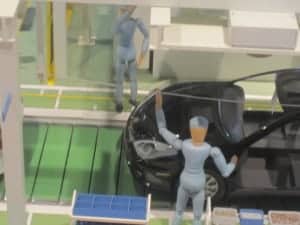
Yesterday, I was able to visit Toyota City as part of the Kaizen Institute tour I am a part of. Now, we weren't able to take pictures in the Takaota factory that we visited (they build Corollas and a model called the iQ). I want to write about two things out of everything I saw – “andon” and Kaizen. I will write about Kaizen (improvement) in a later post)
Pictured above is part of an animatronic diorama that's in the Toyota City visitor center. You can see the little figure reaching up to pull an “andon cord” above the line. The andon cord is often described as something that “stops the line” to ensure that defects don't get passed along.
It's more accurate to think of it as a way of signaling a problem. The production workers are expected to pull the cord any time there is a problem or if they even suspect that something is a problem.
Here is a short YouTube video I made of an animatronic andon cord pull from a visitor center display (it's just sort of cute to watch):
They pull the cord and a light flashes on an “andon board” It tells the team leader which station has a problem (and music plays). Within seconds, a team leader (having two stripes on his hat) shows up to help. There is one team leader for every eight workers, on average (or 14% of their labor waiting for problems or responding to them). That might seem very inefficient use of labor, but it helps the line be very efficient (while having high quality).
I saw, in the real plant, the team leaders very involved in the process. Our tour had us on a mezzanine level where we could see down onto the line quite well, as opposed to an aisle-way tram tour that you get at the Toyota plant in San Antonio.
 Most of the time, the team leader can resolve the problem or verify that it's not a problem before the line would stop. So, the cords are being pulled almost constantly, but the line rarely stops. We did see it stop once (red light on the andon board).
Most of the time, the team leader can resolve the problem or verify that it's not a problem before the line would stop. So, the cords are being pulled almost constantly, but the line rarely stops. We did see it stop once (red light on the andon board).
Our Kaizen Institute guide Brad Schmidt emphasized that Toyota leaders might have to make a choice, in bad situation, of taking a $1 million hit now (stop the line) or a $10 million hit later (if they didn't stop it). They make the right decision for the long-term. Some problems might be fixable at the end of the line (steering wheel) but some cannot (a wiring harness deep in the guts of the car). So, it seems that they don't abide by the idea of NEVER passing on a defect to the next station…
In our introductory discussions about Japanese culture, Brad talked about the importance of harmony (“Big Harmony”) in Japanese culture. Because of the overwhelming need for harmony, people often wouldn't naturally speak up. They might be more willing to cover up a problem than to really fix it. So, the andon cord is a mechanism that makes it easier for people to speak up.
This was a huge “a-ha” moment. People like to talk about Lean and the Toyota Production System methods are somehow perfectly aligned with Japanese culture and that this alignment is a big reason why it works (and would somehow be an excuse for why it wouldn't work in other countries). Brad said that this speaking up to highlight problems “doesn't come naturally” to Japanese (he knows this because he was born here and has lived in Japan for 21 years).
Because it “doesn't come naturally,” they need systems to make it possible.
So, I hope this is an inspiration to people who think “Lean doesn't come naturally to us in our country.” It doesn't always come naturally to the Japanese, even.
Please scroll down (or click) to post a comment. Connect with me on LinkedIn.
Let’s work together to build a culture of continuous improvement and psychological safety. If you're a leader looking to create lasting change—not just projects—I help organizations:
- Engage people at all levels in sustainable improvement
- Shift from fear of mistakes to learning from them
- Apply Lean thinking in practical, people-centered ways
Interested in coaching or a keynote talk? Let’s start a conversation.








![When Was the Last Time a Leader Around You Admitted They Were Wrong? [Poll]](https://www.leanblog.org/wp-content/uploads/2025/07/Lean-Blog-Post-Cover-Image-2025-07-01T212509.843-100x75.jpg)

This is interesting to learn of the differences between what we either read or are taught regarding the degree to which Toyota adheres to what we would consider lean thinking. It appears that they think through each situation without blindly adhering to dogma, which truly is lean thinking. I’d imagine this is one fascinating “go and see” experience for you, Mark.
This is good stuff. Looking forward to more of your observations. Thanks.
Yes, it seems like thinking and evaluating tradeoffs (while remaining customer focused and taking the long-term view) is their ideal state.
Mr. Yoshido, so worked there for 40 years talked to us about always wanting to look at the advantages and the disadvantages of a proposal. People often think you are being critical (outside of Toyota) if you ask about the disadvantages. He teaches at a college now, in Japan, that seems to have what we’d recognize as a “traditional” organizational culture… “there’s no disadvantages, this plan is perfect” is the response when he asks or people think he’s being critical (which is viewed as bad) for wanting to help the organization improve.
Toyota is clearly not a proxy for all Japanese companies.
Great post Mark! Really gets you thinking about the possibility that there are other system design possibilities to help us with behaviors that don’t come naturally. For example, I’m with a client who has not been able to get leadership buy-in for a true process owner who crosses functions. But until someone is put in this role, the process will never function as it could/should. It’s a highly silo’d environment with a legacy of not thinking holistically. I’m now noodling on whether there’s some sort of system that could create the holistic process management methods they and others desperately need. Hmmm….
Thanks Mark, I’m enjoying your insights from the visit.
A couple of interesting points in there. Firstly I agree with the common misconception the Andon is a tool to stop the line. This was one of the first things I was tought through ex Toyota mangers. It highlights a potential problem in the eyes of the team member that can then be solved without stopping the line if possible (starting with Team Leader response). It may ultimately lead to a line stop but only when the impact of the problem is understood. Also the principle of no faults forward is something that is strived for but in reality the right decision in some circumstances may be to pass on but only if clarified and agreed by the next line customer.
In a business where Lean is in the early stages of implementation then quality at source cannot be achieved overnight although negotiation with the customer of the problem and level of impact can be.
Secondly, Karen raises an interesting point about system design with a view to creating the right behaviours. This is my current area of focus and currently one of the most underestimated focal points of Lean implementation. We can design systems that create the right behaviours but only when we first understand the impact of current system behaviours.
I believe the ability to think systemically is the major differentiator in a successful Lean Transformation.
“14% of their labor waiting for problems or responding to them”
This makes it sound like waiting for problems and responding to them is all the leader does, is that right? If not what percent of the leaders time is spent on these activities?
In the scope of the post “responding to them” is largely seen (by readers, I am guessing) as immediate responses – not in instituting a fix and then spending the down time the next 2 days to think about potential causing of the problem, start an A3 report or such like activities. Those activities could be classified as “responding to them” but those activities are seem better classified as working on improving the system to me.
I would be interested in whatever details on the questions I raise you have.
Yes, “responding” includes a short-term action (pick up the dropped bolt) and a longer-term improvement countermeasure (improve tools, etc. so that bolts are less likely to be dropped in the future).
There’s both putting the fire out AND improving the system to prevent future fires.
[…] Andon Cords at the Toyota Takaota Plant by Mark Graban – “They pull the cord and a light flashes on an ‘andon board’ It tells the team leader which station has a problem (and music plays). Within seconds, a team leader (having two stripes on his hat) shows up to help. There is one team leader for every eight workers, on average (or 14% of their labor waiting for problems or responding to them).” […]
[…] As I wrote about before, many aspects of “Lean” culture “don’t come naturall…” in Japanese business culture. People don’t naturally speak up, because the culture says “don’t make waves.” The organizations we visited were, to some extent, all trying to create a culture that was different than typical Japanese business culture. […]
[…] not just “Behaviors” and “Artifacts” (or tools). Artifacts like an andon cord or an “idea board” are the result of shared beliefs and consistent behaviors that are […]
[…] We could put in systems to amplify the culture (an example of this is type of system would be the Andon cord at Toyota or Google’s CEO signing off on every single hire at the company). We could put in policies to […]
[…] you want to learn more about andon, Mark Graban has written a good overview about andon at Toyota. I would agree with his observations that andon, and other principles that are core to Lean […]
[…] Many people work in the assembly area – in conjunction with machines and robots to assist with the work. Team leaders wearing different colored hats were on the line, assisting front line operators whenever an andon light was lit up. […]
[…] Toyota learned from the early books of Henry Ford. An American, Dr. W. Edwards Deming was incredibly influential to Toyota and other Japanese companies. It’s probably fair to say that the Toyota management system is a combination of some early Henry Ford ideas, Dr. Deming, and their own innovations. This approach is not predicated on the Japanese national or social culture… since the roots are not all Japanese, these ideas work in other countries, and it’s not naturally easy to “be Lean” in Japan. […]
[…] Andon Cords at the Toyota Takaota Plant – It Doesn’t Come Naturally? […]
[…] love her description of TPS as a countermeasure to some typical Japanese business culture concepts. As I’ve written about, I think the andon cord was a specific countermeasure against the challe…. The andon cord didn’t come naturally. Not even at […]
[…] Detroit News series), of course, led to frustration… people were trying to “pull the andon cord” to ask for help, if you […]